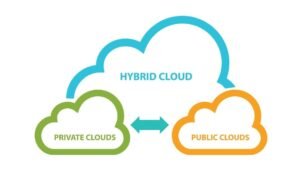In the world of technology, few innovations have had as profound an impact as cloud computing. From its humble beginnings to its current ubiquity, cloud computing has transformed the way individuals, businesses, and organizations store, process, and access data and applications. In this article, we will take a journey through the past, present, and future of cloud computing.
The Past: Early Beginnings
Mainframes and Client-Server Architecture
The concept of sharing computing resources remotely dates back to the 1960s when mainframe computers were the primary computing systems. These mainframes allowed multiple users to access the same central processing unit (CPU) via dumb terminals. This era laid the foundation for the idea of remote computing.
The 1980s brought the client-server architecture, which was a departure from the mainframe model. In this model, multiple users accessed computing resources on a network, but these resources were distributed across a network of powerful servers. This was a precursor to the distributed nature of cloud computing.
Early Cloud Services
The term “cloud computing” was coined in the 1990s. Companies like Salesforce started delivering enterprise applications via a simple website, marking the beginning of Software as a Service (SaaS). However, it wasn’t until Amazon Web Services (AWS) launched in 2006 that cloud computing took its modern form.
The Present: Cloud Computing Today
Types of Cloud Services
Today, cloud computing offers a variety of services, including:
- Infrastructure as a Service (IaaS): Provides virtualized computing resources over the internet. Examples include AWS EC2 and Azure Virtual Machines.
- Platform as a Service (PaaS): Offers a platform that includes infrastructure, middleware, and development tools. Examples include Google App Engine and Heroku.
- Software as a Service (SaaS): Delivers software applications over the internet on a subscription basis. Examples include Google Workspace and Microsoft 365.
- Function as a Service (FaaS): Enables the execution of individual functions in response to events. Examples include AWS Lambda and Azure Functions.
Key Players
Leading cloud service providers include AWS, Microsoft Azure, Google Cloud, IBM Cloud, and Oracle Cloud. These providers offer a wide range of services to cater to diverse customer needs.
Benefits of Cloud Computing
The benefits of cloud computing today include scalability, flexibility, cost efficiency, and the ability to access cutting-edge technologies without significant upfront investment. Cloud computing has democratized access to powerful computing resources.
The Future: Cloud Computing Tomorrow
Emerging Technologies
Several technologies are expected to shape the future of cloud computing:
- Edge Computing: With the proliferation of IoT devices, edge computing is becoming essential. It involves processing data closer to its source, reducing latency and enabling real-time processing.
- Serverless Computing: Serverless platforms abstract the infrastructure, allowing developers to focus solely on code. This approach is gaining popularity and will continue to evolve.
- Quantum Computing: While still in its infancy, quantum computing has the potential to revolutionize cloud computing by solving complex problems in seconds that would take classical computers years.
- AI and Machine Learning: Cloud providers are increasingly integrating AI and machine learning services into their platforms, enabling businesses to harness these technologies without deep expertise.
Security and Privacy
As cloud computing becomes more ingrained in our lives, data security and privacy concerns will grow. Future cloud computing will see advancements in encryption, data sovereignty, and security measures.
Sustainable Cloud Computing
Sustainability is a growing concern. Future cloud computing is likely to focus on reducing energy consumption, using renewable energy sources, and minimizing environmental impact.
Conclusion
The evolution of cloud computing has been remarkable. From its origins as a concept to its current state as a fundamental technology, cloud computing has transformed industries, businesses, and daily life. As we look to the future, cloud computing will continue to adapt and evolve, offering new opportunities and challenges. Embracing these changes and staying informed about emerging technologies will be crucial for businesses and individuals looking to harness the full potential of the cloud.






